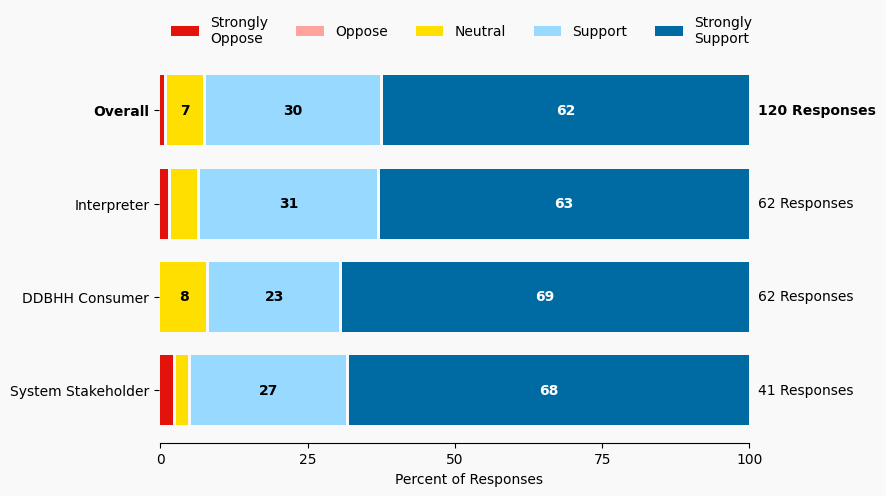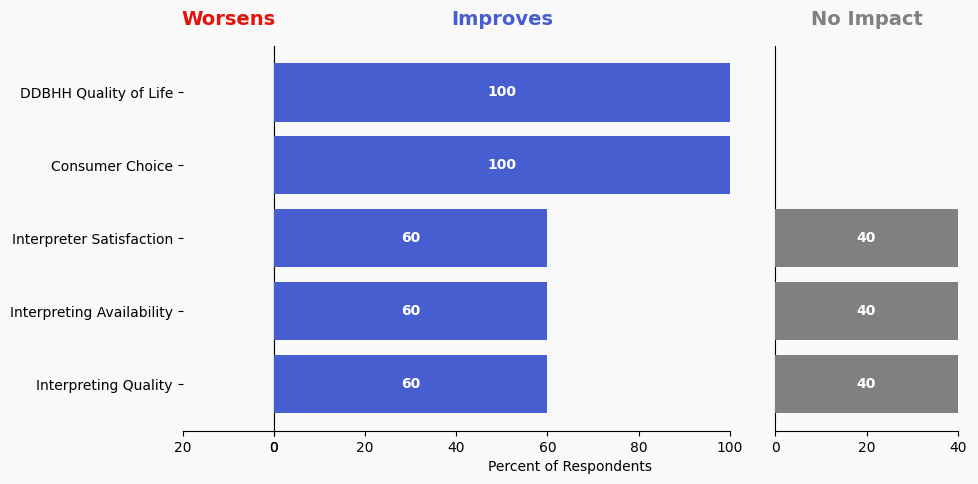76 Encourage More ASL-Fluent Mental Health Professionals for Direct Access to Mental Health Services
Issue: Consumers do not have enough access to interpreters for mental health services.
Proposed Solution: Commission, MDH and State Services spotlight careers in mental health services for DDBHH persons as an area needing more professionals able to communicate directly with consumers.
Expected outcome: Greater awareness of need for mental health professionals to provide direct services to DDBHH consumers, thus potentially reducing the need for interpreters for mental health settings.
Who is impacted: DDBHH consumers seeking mental health services
Timeline: 6 months

Summary of Support Image Description
The stacked bar charts show how respondents rated their level of support and the total number of responses. The percentage for the five support levels is shown from left to right: Strongly Oppose (Dark Red), Oppose (Light Red), Neutral (Yellow), Support (Light Blue), and Strongly Support (Dark Blue).
Respondents may identify with multiple subgroups. The overall level of support is:
Overall
Strongly Oppose: 1%
Oppose: 0%
Neutral: 7%
Support: 30%
Strongly Support: 62%
Click to see the detailed image description for each subgroup.
Interpreter
Strongly Oppose: 2%
Oppose: 0%
Neutral: 5%
Support: 31%
Strongly Support: 63%
DDBHH Consumer
Strongly Oppose: 0%
Oppose: 0%
Neutral: 8%
Support: 23%
Strongly Support: 69%
System Stakeholder
Strongly Oppose: 2%
Oppose: 0%
Neutral: 2%
Support: 27%
Strongly Support: 68%
Overview of Respondents Opting for In-Depth Solution Analysis
After indicating their support level, 3% of the 120 respondents opted in to further assess whether the solution would worsen or improve on five metrics. Of the opt-in reviewers (4 respondents), 75% supported the solution, 0% were neutral on the solution, and 25% opposed the solution.
The remaining 116 respondents did not opt in to further assess the solution. Of these people, 93% support the solution, 6% were neutral on the solution, and 0% opposed the solution.
Reviewer Evaluation of Solution Effectiveness

Solution Effectiveness Image Description
The stacked bar charts show how respondents assessed the effectiveness of this solution based on five metrics. For each metric, the percentage of respondents is shown from left to right: Worsens (Red), Improves (Blue), No Impact (Gray).
DDBHH Quality of Life
Makes It Worse 0%
Makes It Better 100%
No Impact 0%
Interpreter Satisfaction
Makes It Worse 0%
Makes It Better 60%
No Impact 40%
Consumer Choice
Makes It Worse 0%
Makes It Better 100%
No Impact 0%
Interpreting Availability
Makes It Worse 0%
Makes It Better 60%
No Impact 40%
Interpreting Quality
Makes It Worse 0%
Makes It Better 60%
No Impact 40%
Reviewer Feedback and Insights
Interpreter
Comments from Interpreters agree that while direct services are ideal, the issue is beyond the scope of the interpreter-focused solutions, and more awareness and training on interpreting in mental health settings should be prioritized.
Deaf, DeafBlind, Hard of Hearing
No comments were submitted.
System Stakeholder
One comment from a System stakeholder notes that while direct access is better, the focus should be on improving interpreter training for mental health settings, leaving the recruitment of mental health professionals to other agencies.
PREVIOUS SOLUTION
75 Advocate for Health Care Systems to Develop Welcome Packets
Issue: Consumers need more information about resources in health care systems
NEXT SOLUTION
77 Increase Number of Qualified Mental Health Interpreters via Grant Funding
Issue: Consumers do not have enough access to interpreters for mental health services. Time and funds to attain a Qualified Mental Health Interpreter (QMHI) Certification are a challenge for many working interpreters. Minnesota has only two QMHI Supervisors.
Leave a Reply